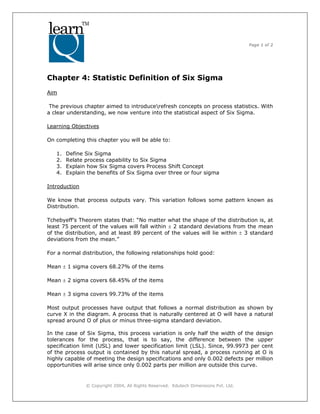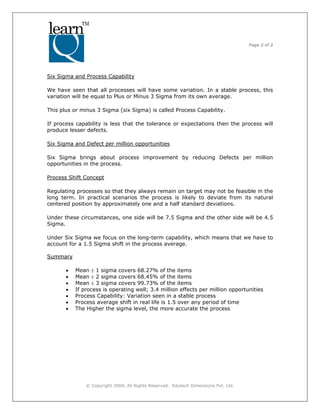6 Sigma - Chapter4
- 1. Page 1 of 2 ? Copyright 2004, All Rights Reserved. Edutech Dimensions Pvt. Ltd. Chapter 4: Statistic Definition of Six Sigma Aim The previous chapter aimed to introducerefresh concepts on process statistics. With a clear understanding, we now venture into the statistical aspect of Six Sigma. Learning Objectives On completing this chapter you will be able to: 1. Define Six Sigma 2. Relate process capability to Six Sigma 3. Explain how Six Sigma covers Process Shift Concept 4. Explain the benefits of Six Sigma over three or four sigma Introduction We know that process outputs vary. This variation follows some pattern known as Distribution. TchebyeffĄŊs Theorem states that: Ą°No matter what the shape of the distribution is, at least 75 percent of the values will fall within ĄĀ 2 standard deviations from the mean of the distribution, and at least 89 percent of the values will lie within ĄĀ 3 standard deviations from the mean.Ąą For a normal distribution, the following relationships hold good: Mean ĄĀ 1 sigma covers 68.27% of the items Mean ĄĀ 2 sigma covers 68.45% of the items Mean ĄĀ 3 sigma covers 99.73% of the items Most output processes have output that follows a normal distribution as shown by curve X in the diagram. A process that is naturally centered at O will have a natural spread around O of plus or minus three-sigma standard deviation. In the case of Six Sigma, this process variation is only half the width of the design tolerances for the process, that is to say, the difference between the upper specification limit (USL) and lower specification limit (LSL). Since, 99.9973 per cent of the process output is contained by this natural spread, a process running at O is highly capable of meeting the design specifications and only 0.002 defects per million opportunities will arise since only 0.002 parts per million are outside this curve.
- 2. Page 2 of 2 ? Copyright 2004, All Rights Reserved. Edutech Dimensions Pvt. Ltd. Six Sigma and Process Capability We have seen that all processes will have some variation. In a stable process, this variation will be equal to Plus or Minus 3 Sigma from its own average. This plus or minus 3 Sigma (six Sigma) is called Process Capability. If process capability is less that the tolerance or expectations then the process will produce lesser defects. Six Sigma and Defect per million opportunities Six Sigma brings about process improvement by reducing Defects per million opportunities in the process. Process Shift Concept Regulating processes so that they always remain on target may not be feasible in the long term. In practical scenarios the process is likely to deviate from its natural centered position by approximately one and a half standard deviations. Under these circumstances, one side will be 7.5 Sigma and the other side will be 4.5 Sigma. Under Six Sigma we focus on the long-term capability, which means that we have to account for a 1.5 Sigma shift in the process average. Summary ? Mean ĄĀ 1 sigma covers 68.27% of the items ? Mean ĄĀ 2 sigma covers 68.45% of the items ? Mean ĄĀ 3 sigma covers 99.73% of the items ? If process is operating well; 3.4 million effects per million opportunities ? Process Capability: Variation seen in a stable process ? Process average shift in real life is 1.5 over any period of time ? The Higher the sigma level, the more accurate the process


